When it comes to the interiors of Castel Sant'Angelo in Rome, we are not only referring to the walls that enclose the famous Hadrian's Mole.
As you enter the castle you will be confronted with a real path through history, which winds its way through roman ramps, renaissance courtyards, frescoed rooms, underground prisons e papal apartments.
Each level of the monument enshrines rooms with different functions: spaces created as imperial mausoleum, then adapted to military fortress, transformed into pontifical residence and, finally, enriched by art collections that you can admire today as part of the National Museum of Castel Sant'Angelo.
The interiors are thus not a static set of rooms, but a layered narrative of almost two thousand years.
From the Roman Dromos to the sumptuous Pauline Hall, via the Library and the striking Treasure Room, each room testifies to a different use of the castle and reveals its evolution over the centuries.
If you plan to visit these unique environments, I recommend that you purchase your ticket for Castel Sant'Angelo so you can avoid queues and enjoy the experience more leisurely.
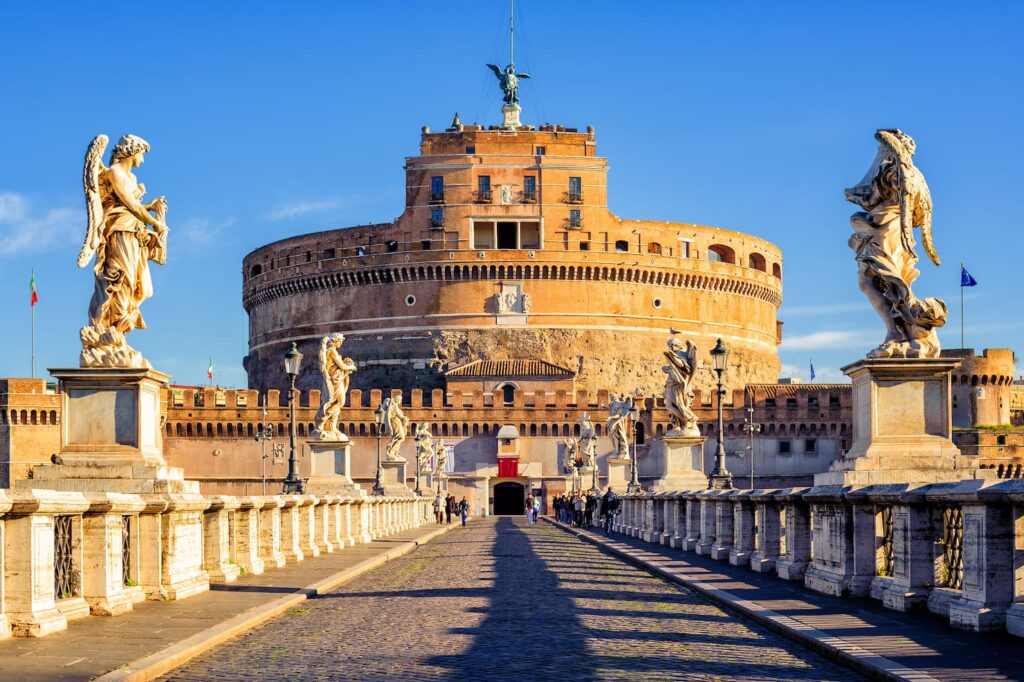
The best-selling ever
Castel Sant'Angelo: Entrance ticket + audio guide
Quick access and audioguide included: explore Castel Sant'Angelo and Roman Forum with one ticket.
Secure payment
Immediate confirmation
Cell phone ticket
What to see inside Castel Sant'Angelo
Visit the interiors of Castel Sant'Angelo means going up floor by floor in a building that has changed its face several times over the centuries. The tour is designed to take you through this transformation, starting from its Roman origins and ending in the most sumptuous rooms of the papal era.
The first level is the oldest one: the Roman core wanted by the emperor is preserved here. Adriano, with the helicoidal ramp and rooms related to the mausoleum. This is the beginning of the journey, between monumental spaces and rooms related to funerary worship.
The second level tells about the military vocation of the castle. Here you will find the Cordonade of Paul III, the patrol trenches and ramparts that made the fortress an impregnable bastion, as well as access to the famous Passetto di Borgo, secret corridor connecting the Vatican to Castel Sant'Angelo.
The third level guards more austere environments, such as the prisons and the Oiling, where provisions and supplies were stored. It is the darkest part of the interior, showing the function as a place of detention and control.
The fourth level Instead, it marks the beginning of the transformation into a papal residence. This is where the inner courtyards, chapels and the first reception rooms opened.
The fifth level is the artistic and scenic heart of the castle, with rooms such as the Pauline Hall, the Perseus Hall and the Hall of Cupid and Psyche, where frescoes celebrate the greatness of the Renaissance popes.
The sixth level hosts particularly fascinating environments such as the Library and the Treasure Hall, related to the administrative and political function of the fortress.
The route finally culminates on the Angel Terrace, dominated by the statue of St. Michael the Archangel. From here you can admire Rome from above, retracing with your eyes the path you just took inside the castle.
Level 1 : The Roman Core
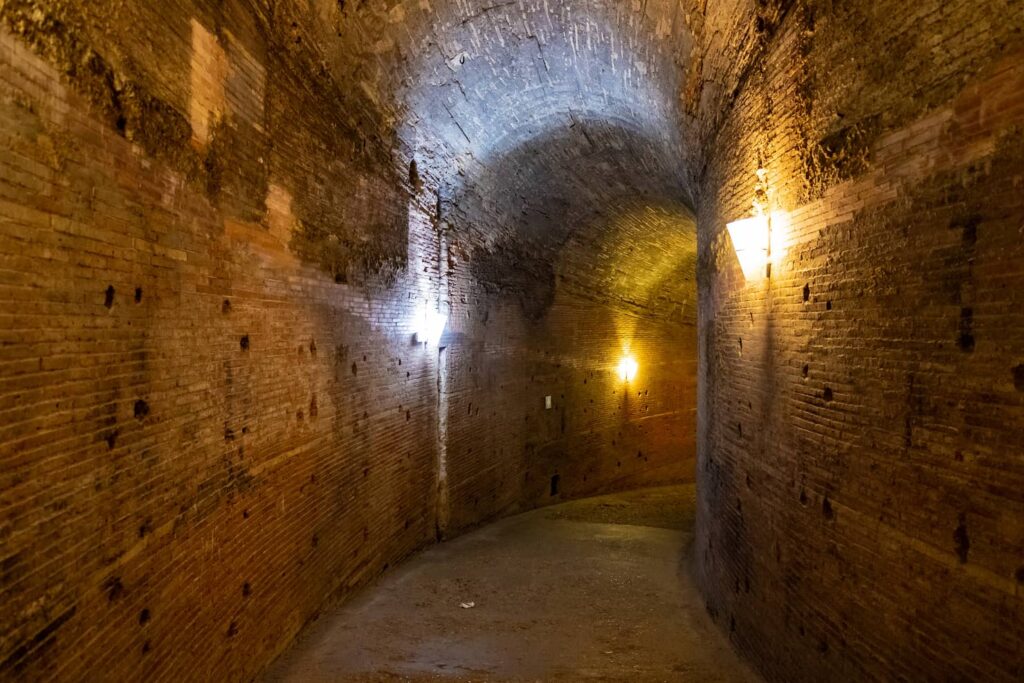
The first level of Castel Sant'Angelo coincides with the original heart of the mausoleum built by Emperor Adriano in the second century AD. Here you immediately come into contact with the primary function of the building: that of imperial sepulchre.
As soon as you walk through the entrance you are greeted by the Dromos, the long corridor that led to the center of the mausoleum. From here starts the famous helical ramp, an impressive spiral passage connecting the ground floor with the upper levels. Walking over it you can imagine the solemn funeral processions that accompanied the urns of emperors to the Urn Hall, the symbolic and sacred heart of the monument.
Surrounding the central core is theAmbulacrum of Boniface IX, a wide vaulted corridor that originally had a monumental function, decorated with marble and stucco to enhance the majesty of the mausoleum. In medieval times, under the pontificate of Boniface IX, it was transformed into a service and control space, becoming an integral part of the fortress. Today it represents one of the most significant points to grasp the transition from a funerary building to a defensive machine.
This level also houses rooms that recount dramatic moments in the life of the castle. The Chapel of the Condemned, for example, was designated for the last prayers of prisoners awaiting execution, while the Shooting Courtyard recalls the death sentences that occurred in later centuries when Castel Sant'Angelo was used as a prison.
Walking through these spaces you perceive all the stratification of the monument: from the mausoleum of Hadrian at papal fortress, from the eighteenth-century chapel at place of punishment. The first level is therefore essential to understanding the castle's roots and how Rome has been able to reuse and transform its architecture over time.
The Ambulacrum of Boniface IX
L'Ambulacrum is a long vaulted corridor that runs around the cylindrical core of the mausoleum. It was originally part of Hadrian's tomb architecture, designed to surround and protect the Urn Hall. It was a monumental room, clad in fine marble and embellished with decorations now lost, giving solemnity to the funerary heart of the mausoleum.
With the transformation of Castel Sant'Angelo into a fortress, the corridor was repurposed for practical and defensive purposes. It was precisely under the pontificate of Boniface IX (1389-1404) that this space took on its current name, becoming an integral part of the castle's war machine and internal control system. From here the heart of the structure could be monitored and access to the upper floors regulated.
Today, walking along the Ambulacro, you have the feeling of walking through a passageway suspended between two epochs: on one side the imperial splendor of Hadrian's Rome, on the other the severity of the medieval papal fortress. It is an environment that tells with immediacy the metamorphosis of Castel Sant'Angelo, capable of surviving over the centuries by adapting to ever new functions.
The Dromos
The Dromos of Castel Sant'Angelo is the first room you encounter as you enter the heart of Hadrian's mausoleum. It is a long rectilinear corridor, now rather bare, but it had a solemn and precise function: to accompany the funeral procession to the innermost part of the monument, where the imperial urns were kept.
In Roman times, the Dromos was lined with marble slabs and marked by an architectural rhythm designed to impress those who passed through. It was not a simple passage, but a kind of "introduction" to the majesty of the mausoleum, a symbolic threshold marking the gap between the world of the living and the world of the dead.
This corridor led directly to the helical ramp, the great spiral that led up to the center of the mausoleum and to the Urn Hall. Walking along the Dromos today, though devoid of its ancient decorations, you can easily imagine the solemn atmosphere that characterized it: torches, marbles, and the silence of imperial funeral rites.
Over the centuries, when Castel Sant'Angelo lost its original function and became a fortress, the Dromos was reused as a simple passageway. However, it remains one of the most important spaces for understanding the original layout of the building and the castle's role as a dynastic mausoleum.
The helical ramp
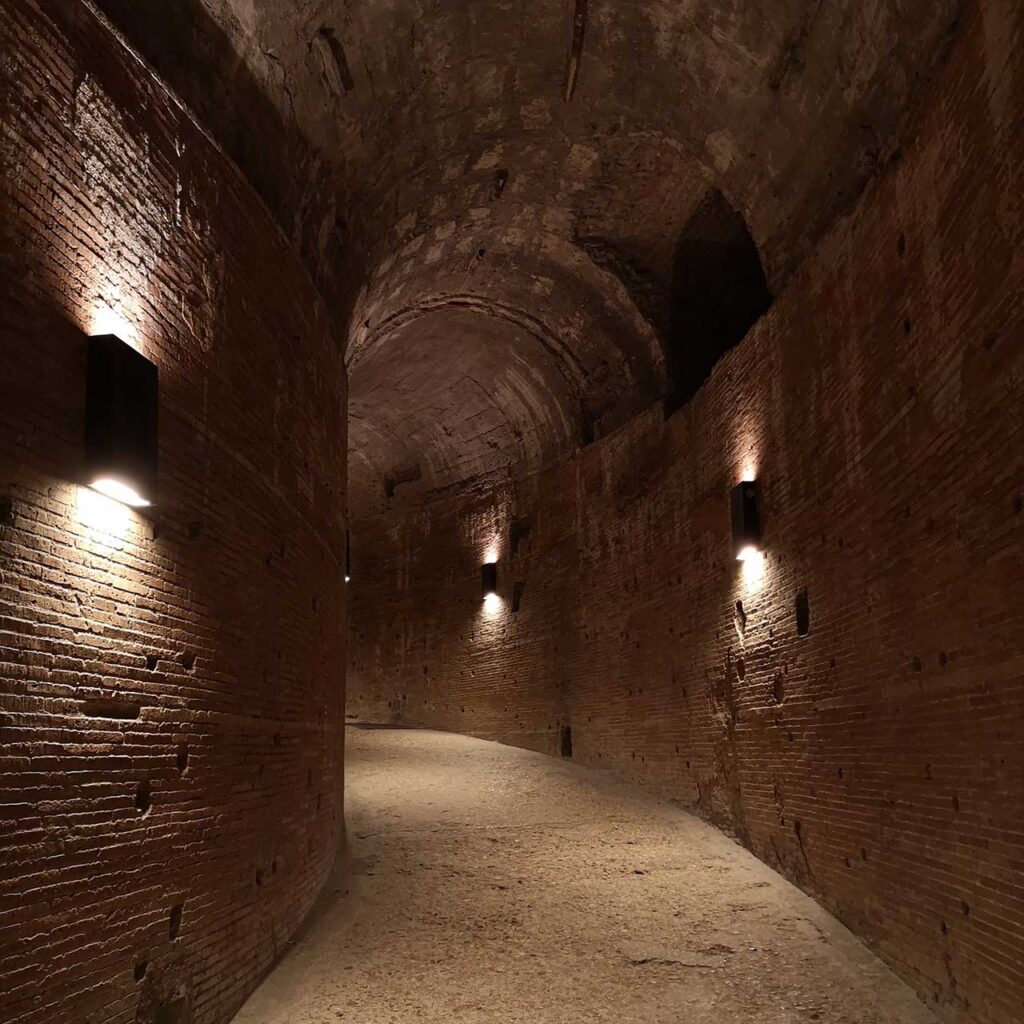
The helical ramp of Castel Sant'Angelo is one of the most fascinating architectural elements of the monument. It is a spiral corridor that wraps around for almost 120 meters, connecting the entrance floor with the upper levels. It is a veritable backbone of the mausoleum, built to allow the solemn passage of funeral processions leading the imperial urns to the central hall.
Imagine the processions that accompanied the emperor Adriano and its successors: horse-drawn chariots, priests and soldiers slowly ascending this wide pathway, designed precisely to make possible the transportation of sarcophagi and ceremonial furnishings. The ramp was originally lined with travertine blocks and decorated with marbles, emphasizing its solemnity.
Even today, walking along it, you can sense the grandeur of the Roman design: the continuous curve and gentle slope give the impression of a slow and majestic ascent. As the centuries passed, the ramp did not lose its strategic function: in medieval and Renaissance times it was adapted for the transit of troops, horses, and even artillery, thus becoming a key element of the defensive machine Of the castle.
Urn Hall
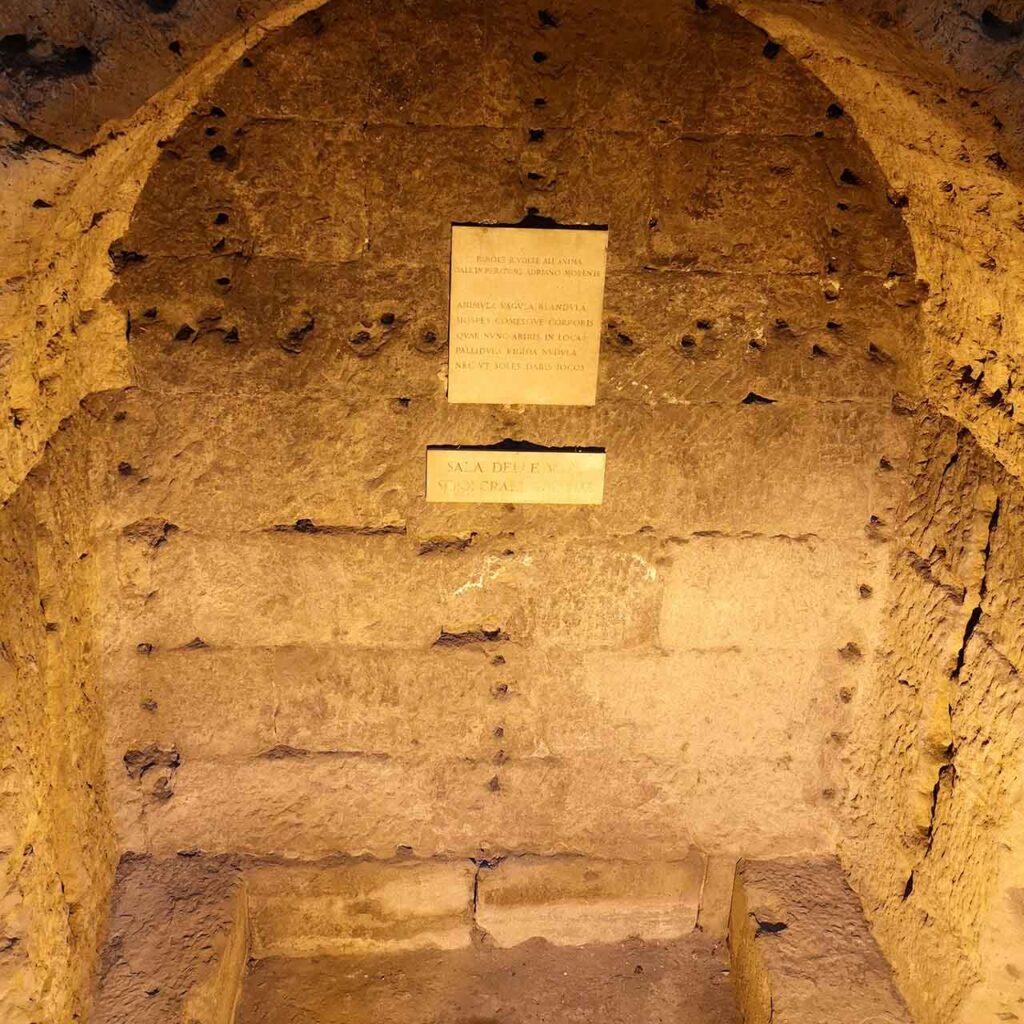
The Urn Hall is one of the most striking spaces in the Museum of Castel Sant'Angelo, because it represents the original heart of the monument. Here, in the second century A.D., were kept the cinerary urns of Hadrian's imperial family, the same emperor who had the mausoleum built.
The hall has a square floor plan (about eight meters on each side) and is built with large travertine blocks, originally completely covered with precious marbles. On the side walls open two large niches which probably housed the tombs of the dynasty. The atmosphere is austere and solemn: when you enter, it is impossible not to feel the sacredness of this space.
One detail that excites many visitors is the marble plaque with a Latin inscription, engraved with the words that the same Adriano Dedicated to his soul:
Little lost and gentle soul, companion and guest of the body, now you are about to descend to colorless, arduous and bare places, where you will no longer have the usual amusements...
These verses, known as theanimula vagula blandula, represent one of the most celebrated texts in Latin literature and give us a picture of an educated, sensitive emperor aware of the transience of life.
The Urn Hall is not just an archaeological site: it is the point where the history of the mausoleum meets that of the museum. By visiting it, you can take a journey back almost two thousand years, going back to the time when Castel Sant'Angelo was not yet a castle, but a imperial mausoleum.
The shooting yard
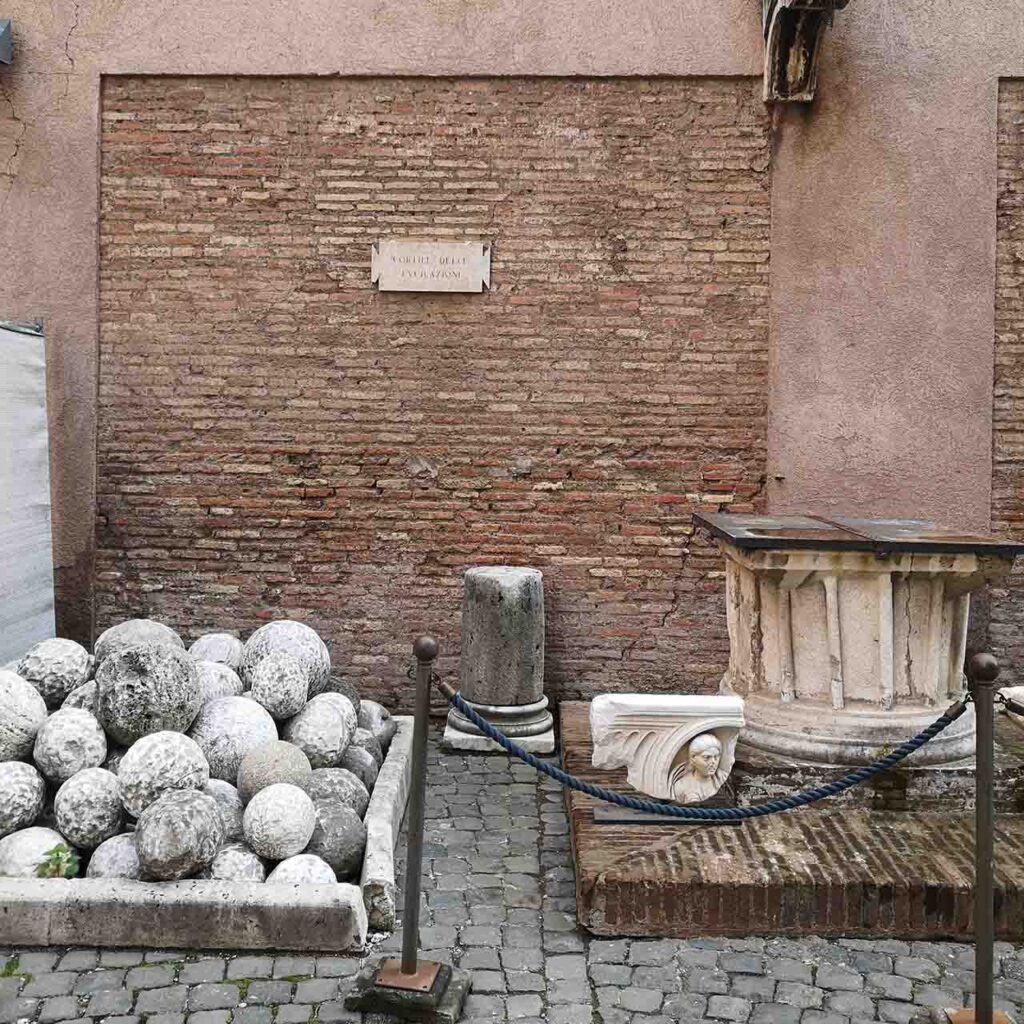
The Shooting Courtyard is located in the northeast corner of the base wall of the first level, next to the portico of Clement X's Armory. For a long time it was the silent setting for executions inside the castle, reserved for those who were not to attract too much attention. This was where those sentenced to death were led to be executed.
A poignant detail: every time a capital punishment was inexorably carried out, from the Angel Terrace - high above the castle - played the Mercy Bell, to remind you that every step in the castle is marked by the cruelly real layering of History.
The chapel of the condemned
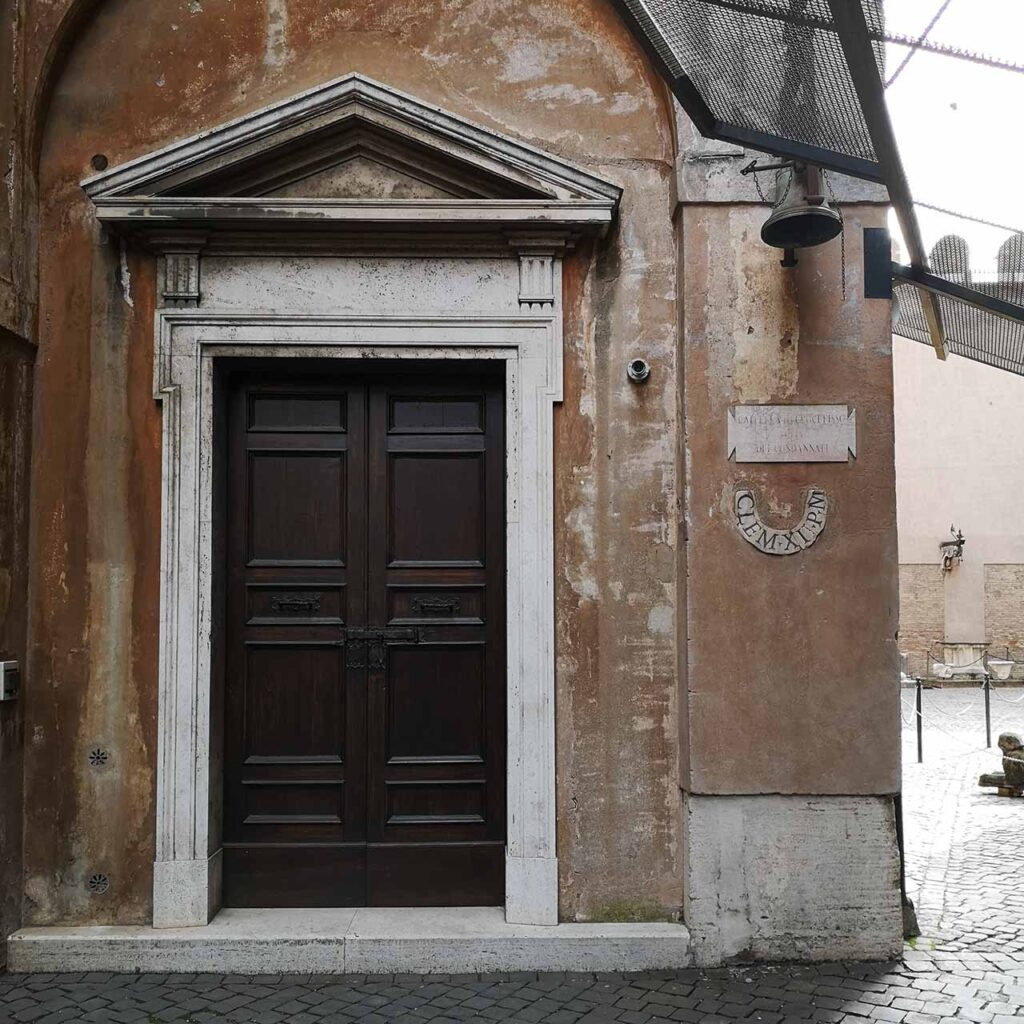
Just next door you find the Chapel of the Condemned, an evocative and emotionally charged environment.
It was originally a porch designed as a Gunpowder store for the Armory granted by Clement X around 1670. It was not until the mid-eighteenth century that it was transformed and consecrated as a chapel, intended for the prisoners who would be shot shortly thereafter.
Under your eyes they return Winged putti, marble epigraphs, stucco work and a polychrome marble altar (placed in 1934), all finely restored to recall the dramatic theatricality of the scenes and the tragic sacredness of the place.
The surfaces, cleaned and treated, let the following stand out. the original color tones and the fine materiality of the materials.
Today this chapel is no longer a place of poignant prayer: it has been turned into a multipurpose conference room, but which visually retains its intense atmosphere, thanks to the restoration that captured its historical essence without erasing it.
You are at a point where the military function, the human drama and the historical memory meet. The courtyard shows you the harshness of the sentences; the chapel elegantly reminds you of the last prayers of those who suffered them. It is a symbolic summit that explains better than many texts what it means to traverse the interior of Castel Sant'Angelo.

The best-selling ever
Castel Sant'Angelo: Entrance ticket + audio guide
Quick access and audioguide included: explore Castel Sant'Angelo and Roman Forum with one ticket.
Secure payment
Immediate confirmation
Cell phone ticket
Level 2 : The defensive machine
Going up to the second level of Castel Sant'Angelo enter the heart of its transformation into papal fortress. Here spaces no longer have anything of Hadrian's funerary monumentality: they become functional, designed for defense and control.
One of the most scenic elements is the March patrol, a long patrol corridor running along the perimeter of the castle. From here the soldiers could guard the walls, moving quickly from bastion to bastion and keeping an eye out for any threats from outside. Walking there today gives the same perspective that medieval guardians had: a direct look at Rome, with the ability to catch any suspicious movement.
Alongside the March patrol, the Cordonade of Paul III, the monumental ramp that facilitated the movement of men and artillery within the fortress. It is a clear example of how the castle had been reorganized for war purposes.
At this level you also find the corner bastions, strategic points of defense from which it was possible to repel attacks. But the real star remains the famous Passetto di Borgo, the elevated corridor built in the 13th century that connects Castel Sant'Angelo with the Vatican, allowing the popes safe refuge during sieges and revolts.
The second level is thus a concrete demonstration of the metamorphosis of the monument: from mausoleum to perfect military machine, capable of combining control, protection and power.
The Cordonade of Paul III
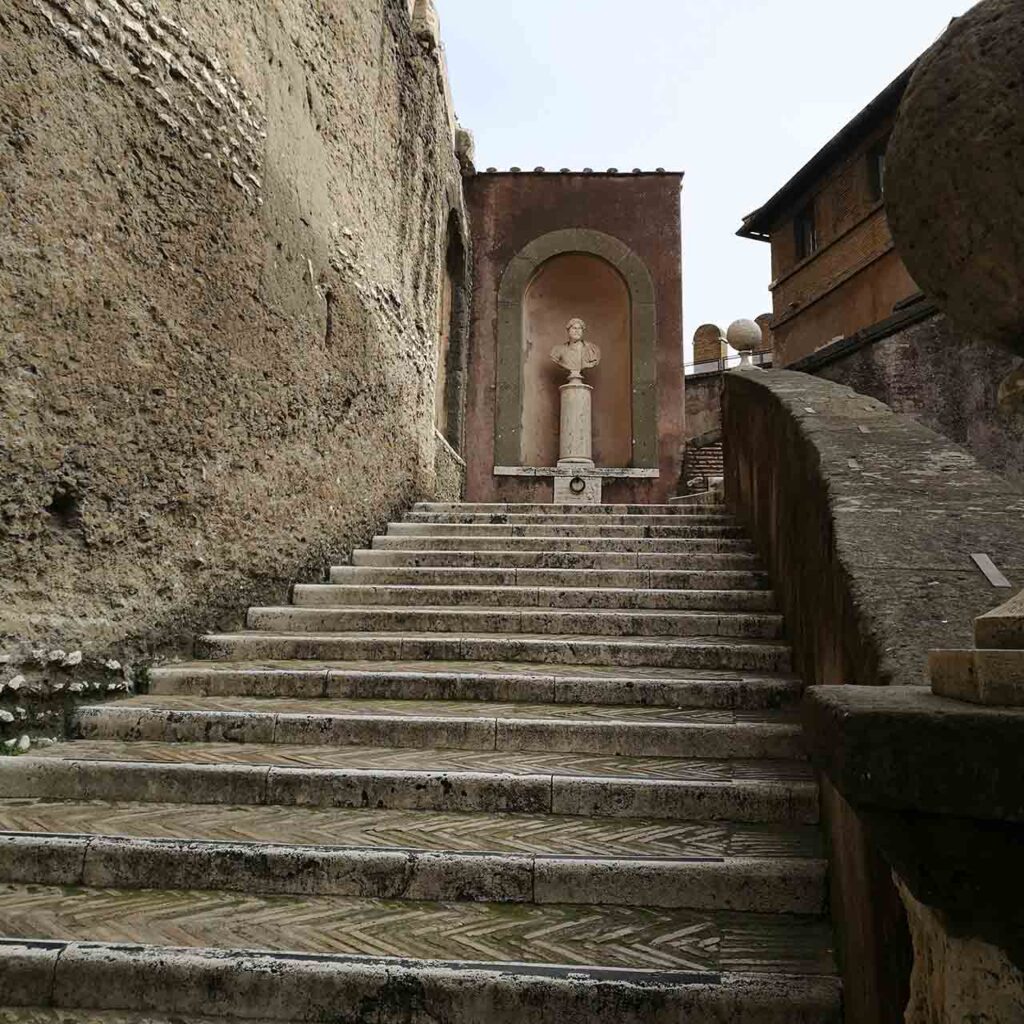
The Cordonade of Paul III is one of the most impressive and significant structures on the second level of Castel Sant'Angelo. Built in the 16th century at the behest of Pope Paul III Farnese, this long paved ramp represents the tangible sign of the castle's transformation into a real renaissance papal fortress.
The cordonade connected the different interior rooms, facilitating the transit of soldiers, horses, and artillery. Unlike traditional staircases, its gentle slope was designed to allow the movement of even the cannons and war wagons, thus making the defense of the complex more efficient. It was not only a practical solution: it was also an architectural element designed to impress, with its monumentality evoking strength and power.
Walking along the cordonade, you can imagine the sound of marching troops and the passage of horses laden with weapons. Every detail served the military logic: its large size ensured speed of movement, while its strategic location connected the nerve centers of the fortress, from the inner courtyard to the ramparts.
The Passetto di Borgo
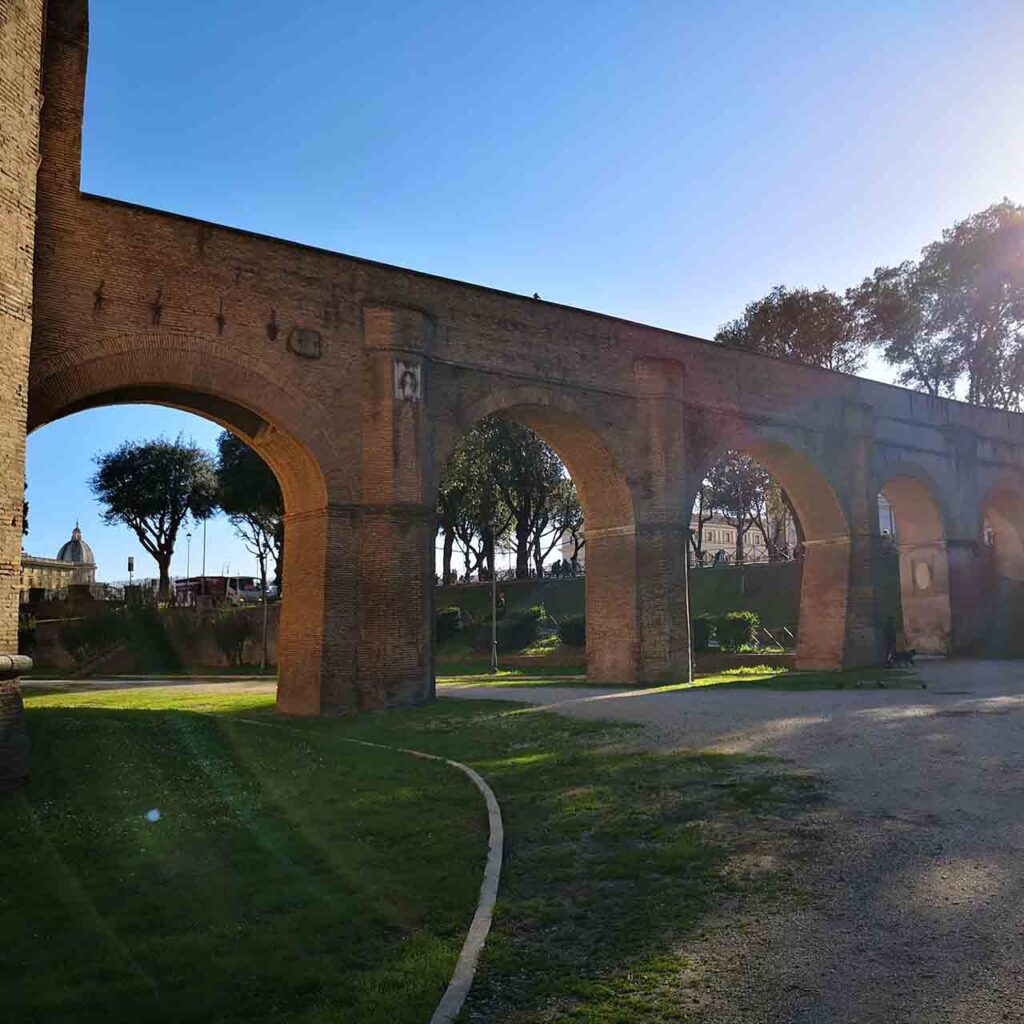
The Passetto di Borgo is undoubtedly one of the most fascinating elements of Castel Sant'Angelo and, at the same time, one of the most famous. It is a elevated fortified corridor, about 800 meters long, which directly connects the fortress to the Vatican Palaces. It was built in 1277 at the behest of Pope Nicholas III Orsini, with the aim of providing the pontiff with a safe escape route in case of danger.
The passetto runs along the top of the Vatican walls and, to this day, is still a crenellated, enclosed and protected walkway that connects in an almost straight line the Vatican at Castel Sant'Angelo. Its importance has been crucial at several moments in history: famous is the episode of the Sack of Rome in 1527, when Clement VII managed to save himself thanks to this corridor, taking refuge in the castle while Lansquenet troops were putting the city to the sword.
The Passetto di Borgo was not only an escape route, but also a symbol of the unbreakable bond between the spiritual power of the papacy and the fortress military force. On one side is the Vatican, the religious center of the Catholic world, and on the other is the impregnable stronghold ready to defend it.
Today the passetto cannot be visited every day, but it is opened on special occasions and dedicated guided tours. Check out our tickets page To arrange your visit!
The ramparts of Castel Sant'Angelo
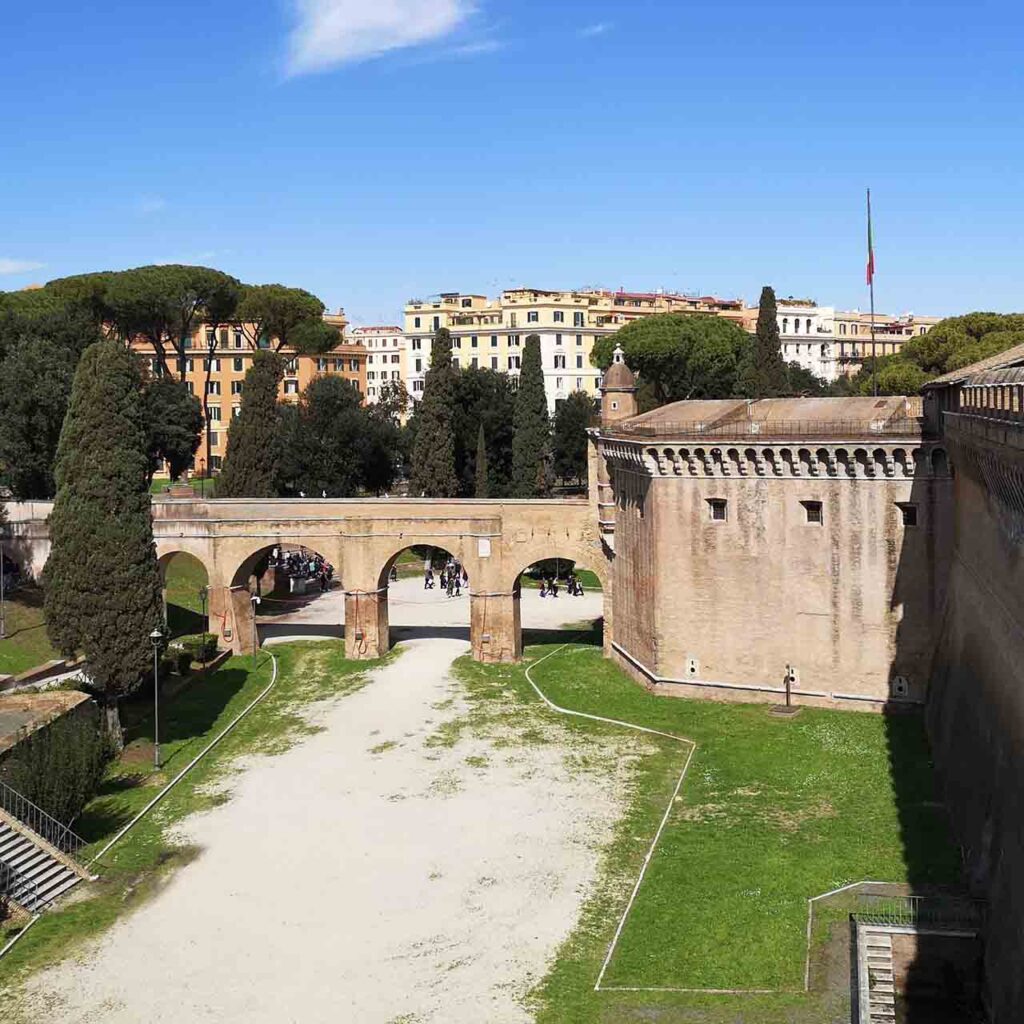
I ramparts of Castel Sant'Angelo represent the most massive and imposing part of its defensive structure. Seen from the outside they immediately give the idea of an impregnable fortress, but visiting them from the inside allows you to grasp their true function: that of ensuring a Total control of the surrounding area and to make the castle a safe bulwark for Rome and the popes.
The ramparts, added and strengthened between the Middle Ages and the Renaissance, form an angular crown around the Hadrianic mole. They were built to resist the new siege techniques and especially the advent of the firearms, when smooth, vertical walls were no longer enough to defend a city. Their protruding shape allowed crossfire and to protect even the most vulnerable parts of the castle.
Walking along the ramparts you can still observe the loopholes and the emplacements from which cannons, crossbows, and arquebuses once sprouted. From these strategic points soldiers kept a watchful eye on the Tiber, the Borgo and the surrounding area, preventing enemies and rebels from approaching without being hit.
The construction of the ramparts was also a political sign: they served to show, at the height of the Renaissance, that the papacy was not only spiritual power, but also military strength and defensive capability. It is no coincidence that popes such as Alexander VI Borgia e Paul III Farnese invested heavily in their upgrading.

The best-selling ever
Castel Sant'Angelo: Entrance ticket + audio guide
Quick access and audioguide included: explore Castel Sant'Angelo and Roman Forum with one ticket.
Secure payment
Immediate confirmation
Cell phone ticket
Level 3 : Prisons and Oiling
The third level of Castel Sant'Angelo is perhaps the darkest and most dramatic. Here the atmosphere changes abruptly: from the large ramps and military ramparts we move to the more austere rooms, where the fortress reveals its function as a prison and place of imprisonment.
One of the most significant spaces is the Talking bowl, a room intended for interrogations and meetings between prisoners and their confessors. It was certainly not a place of comfort: here the distance and the grates were a constant reminder of the condition of those confined here.
Le cells of the third level are small, cold, and dimly lit. Many famous people from history were imprisoned there, including the famous sculptor and goldsmith Welcome Cellini, accused of embezzlement and treason, who left testimony of his imprisonment. These environments allow you to perceive the harsher side of papal power, which also used the castle as an instrument of political control.
Next to the cells you will find the Oiling, large vaulted rooms that originally served as storage for oil, grain and other food supplies. Their function was strategic: to enable the castle to withstand long sieges without having to depend on the outside. In time, these rooms were also reused as service spaces or related to prison activities.
The contrast between the function of the Oliare, linked to the survival and daily life of the fortress, and that of the prisons, marked by the deprivation of freedom, makes this level particularly dense with meaning. It is here that Castel Sant'Angelo shows its most unvarnished face. hard and ruthless, a face that coexisted with the sumptuous face of the papal apartments located only a few floors above.
Prisons
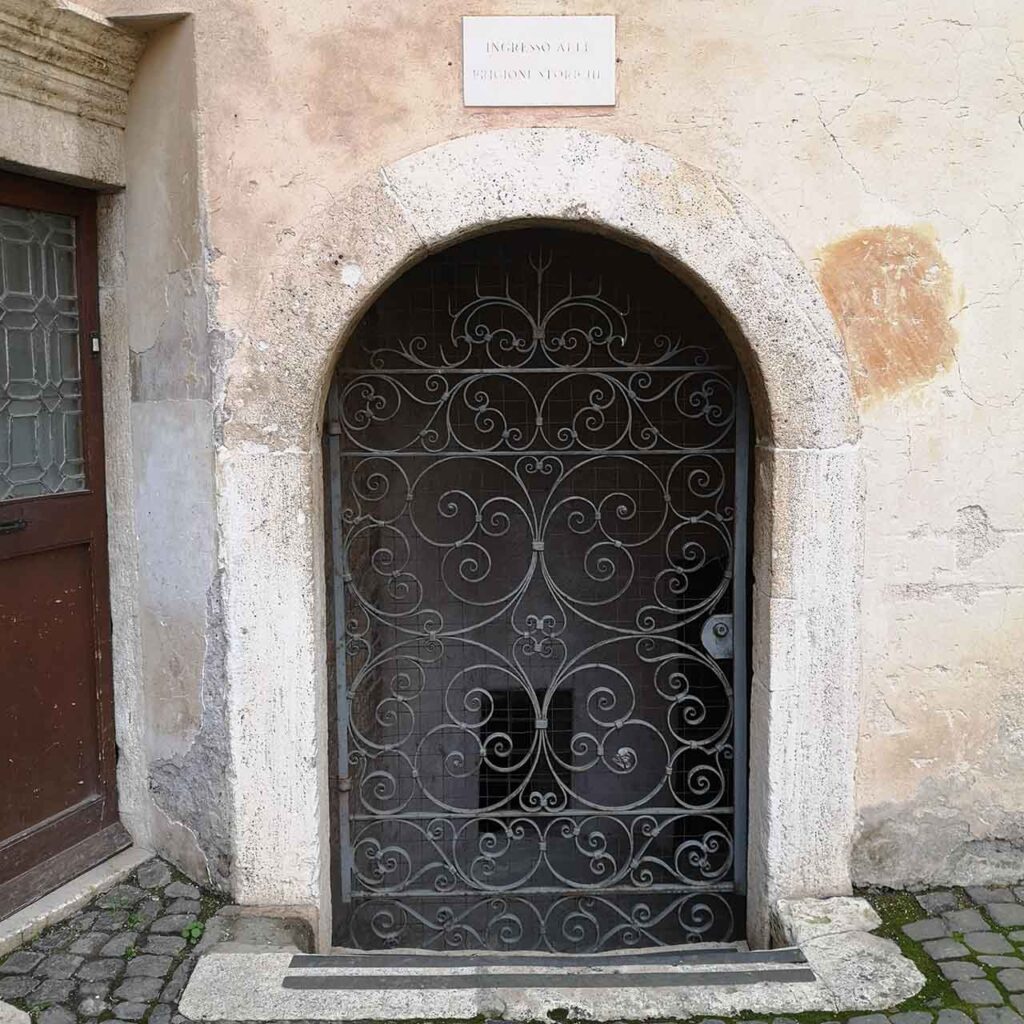
Le prisons of Castel Sant'Angelo are among the most evocative and dramatic environments in the castle. They are not just one large area, but a collection of Cells carved out of dungeons and corridors of the third level, used for centuries as a place of detention for common criminals, political prisoners and even famous people.
The spaces are cramped, dark and damp, with low ceilings and minimal openings, designed to break the physical and psychological resistance of those locked up in them. Some cells were so narrow that one could not even lie down, while others housed several prisoners together in unsanitary conditions.
Among the many famous inmates is. Welcome Cellini, the Florentine goldsmith and sculptor, who recounted his experience of imprisonment in the castle in his autobiography. Cellini even managed to escape a first time, lowering himself with sheets from a window, although he was later captured and brought back in chains inside the fortress.
The prisons of Castel Sant'Angelo were not only a place of punishment, but also of torture and interrogation. Many documents tell of confessions extracted and convicts later taken to the nearby Shooting Courtyard for final execution. There was no shortage of cases of political or religious prisoners, confirming that the castle was also a powerful instrument of control in the hands of the popes.
The Oilers
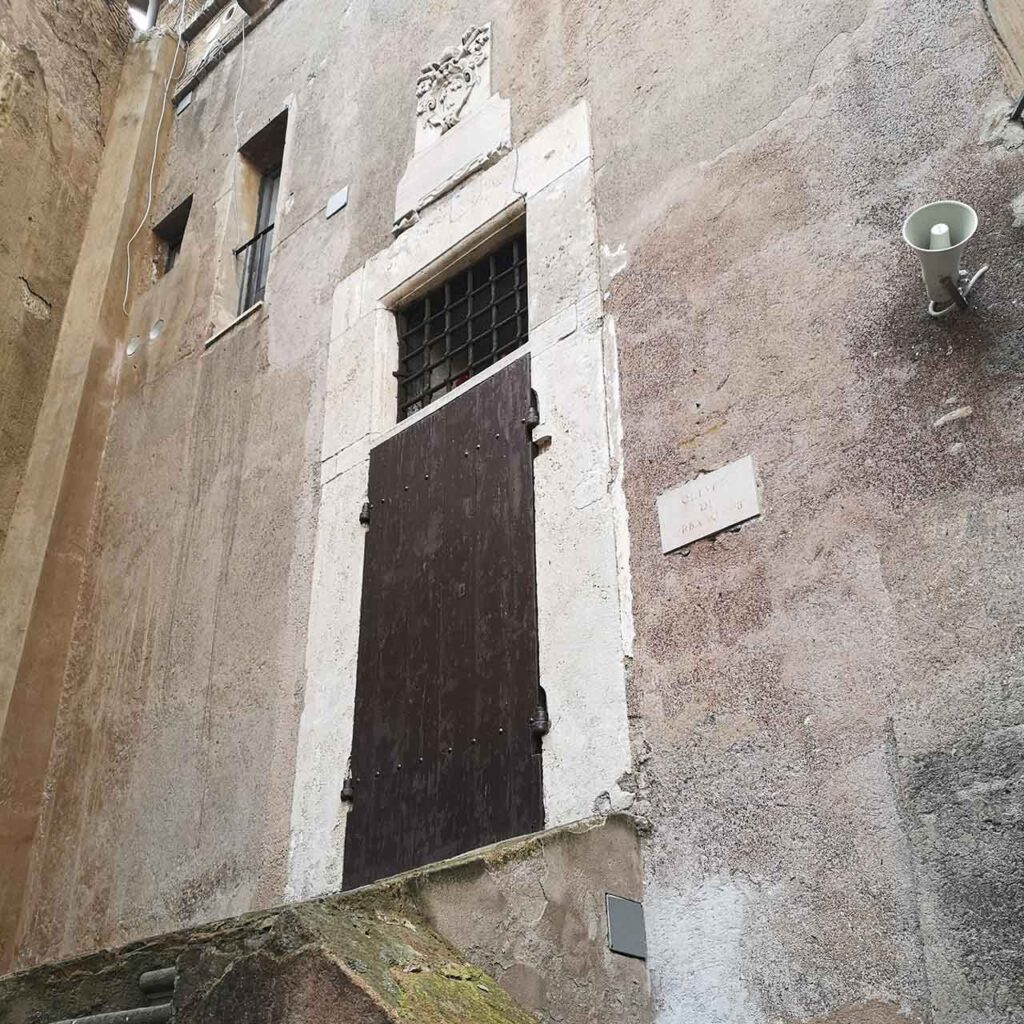
Le Oiling are located on the third level of Castel Sant'Angelo and represent one of the most surprising environments of the fortress. Unlike the cells and prisons, here one did not breathe the harshness of imprisonment, but rather the logic of the survival in time of siege.
The term "oiling" comes from the great amphorae and containers that once filled these vaulted halls. Oil, grain, and other foodstuffs needed to sustain the garrison and castle inhabitants during periods of isolation were stored here. Oil, in particular, was a valuable commodity not only for food, but also for lighting and for wartime uses, such as defensive fire launched on attackers.
Architecturally, the Oliares are striking for their spaciousness: large rooms covered by vaults, with thick walls that ensured constant temperature and protection of supplies. They were thus spaces designed with great functionality, an integral part of the defensive machine that made Castel Sant'Angelo an almost self-sufficient fortress.
Over time, when the castle lost its exclusively military function, the Oliare were also adapted to new uses. In some cases they were exploited as general storage or service spaces, but their original function remains evident to this day.

The best-selling ever
Castel Sant'Angelo: Entrance ticket + audio guide
Quick access and audioguide included: explore Castel Sant'Angelo and Roman Forum with one ticket.
Secure payment
Immediate confirmation
Cell phone ticket
Level 4 : Apartments and Power (I)
With the fourth level of Castel Sant'Angelo dramatically changes the scenery: from the austere spaces of the prisons to the more refined environments, those that have transformed the fortress into a true papal residence. There is a different atmosphere here, made up of frescoes, courtyards, chapels and private rooms reflecting the power and taste of the pontiffs.
The route opens with the Angel Courtyard, named after the bronze statue of St. Michael the Archangel and marking the entrance into the papal area.
From here you can access the Hall of Justice, used as an audience hall, where popes administered power with the same solemnity as Renaissance princes.
Another environment of great interest is the Chapel of Leo X, a small treasure chest of Renaissance art linked to the Medici family pope. It is an intimate space, but enriched with decorations that emphasize its devotional function.
Alongside the official environments you find more intimate spaces such as the Halls of Clement VII, evidence of the daily life of the pontiffs inside the castle. Here stands out the Bath of Clement VII, a striking compartment that shows the pursuit of comfort even within a fortress.
Fundamental to understanding the borgian phase of the castle, however, are the Rooms of Alexander VI. These small rooms, decorated with heraldic and symbolic motifs related to the Borgia family, testify to the private and confidential use of the castle by the most talked about pope of the Renaissance. Despite their small size, they give off a strong symbolic value, linked to the control and ostentation of power.
Closing this level is the striking Hall of Apollo, a room decorated with frescoes inspired by mythology, where the god of music and the arts celebrates the grandeur and culture of the papal court. It is one of the rooms that best show how the fortress was transformed into a place of artistic representation as well, and not just military or defensive.
Angel Courtyard and Loggia of Julius II
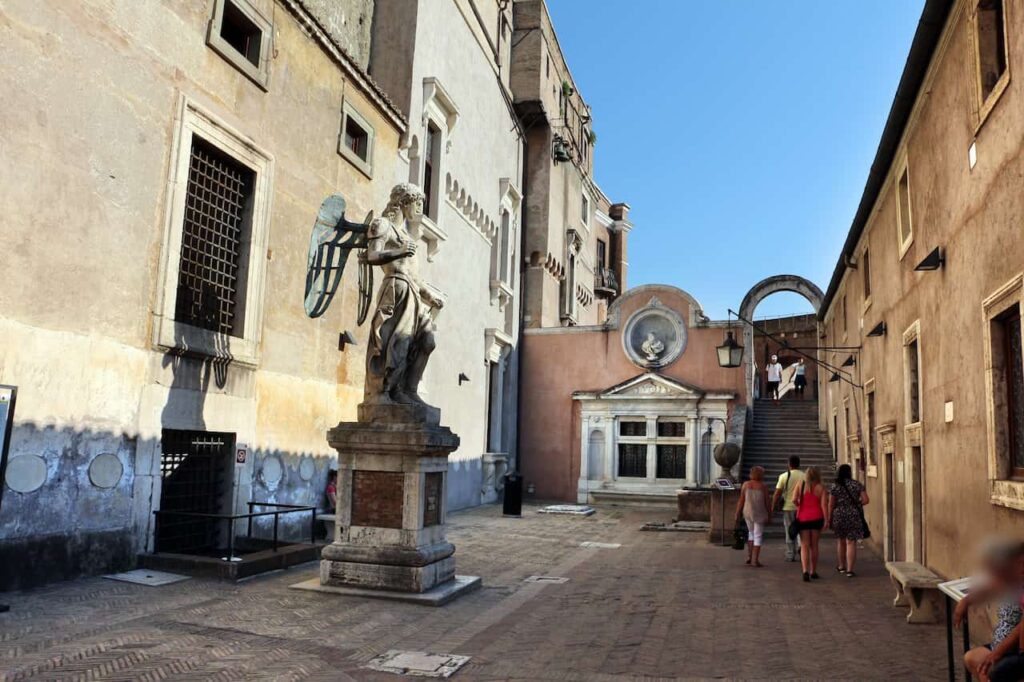
The Angel Courtyard is one of the most striking spaces in the Museum of Castel Sant'Angelo. Originally known as Courtyard of Honor, was the focus of the papal apartments and served as a representative space, privileged access to the richest rooms in the castle.
In the center of the courtyard stands out the marble statue of St. Michael the Archangel, carved in 1544 by Raphael of Montelupo. The figure of the archangel sheathing his sword recalls the legendary appearance during the plague of 590, when Pope Gregory the Great's vision marked the end of the epidemic and gave the castle the name by which we still know it today. Originally the statue was placed at the top of the castle, but after two centuries it was moved here, from which the courtyard takes its name.
The architecture is one of great elegance. On one side faces the Chapel of Leo X, attributed to Michelangelo, on the other hand the Renaissance facades with niches and busts made by William of the Gate. The space is solemn but at the same time intimate, allowing you to perceive the use of the castle as a papal residence And shelter in times of crisis.
A little further on is the Loggia of Julius II, overlooking the Tiber directly. This loggia was built in the early sixteenth century at the behest of Pope Julius II della Rovere, with the supervision of Giuliano da Sangallo and, according to some studies, even of Bramante. The pontiff used it as a place of recreation and meditation, but also as a scenic vantage point over the river.
The loggia's frescoes and decorations, with plant motifs, putti and Latin cartouches, recall the function of lodge of blessings. Here the popes could look out and address the people, always maintaining that balance between sacredness and temporal power that characterizes all of Castel Sant'Angelo.
The Hall of Justice
The Hall of Justice is one of the most solemn environments in the fourth level of Castel Sant'Angelo. The name recalls the function it had in the papal era: here were held the hearings and the processes, often relating to prisoners held in the lower levels. It was thus a place of authority and power, where justice was not just an abstract concept, but a reality that was concretely decided within these walls.
Architecturally, the hall looks like a large rectangular room with a vaulted ceiling and walls once embellished with pictorial decorations and papal coats of arms. Although some of the ornaments have been lost, its monumentality remains evident, reflecting the pontiffs' desire to emphasize their role as supreme justices, both in the religious and temporal fields.
Precisely because of its function, the Hall of Justice is closely connected to the castle's prison quarters. Here sentences were discussed, which in many cases could result in death sentences, which were then carried out in the nearby Shooting Courtyard. It is thus a space that carries the weight of history, marked by dramatic fates and irrevocable decisions.
At the same time, the hall was also a political tool: it served to showcase the power of papal justice, which was not limited to the spiritual sphere but also extended to direct control of the city and its inhabitants. In this sense the Hall of Justice was not only a functional place, but also a symbol of the absolute power of the popes, made even more effective by the austere and imposing setting of the rooms.
The Chapel of Leo X
The Chapel of Leo X is one of the most intimate and atmospheric environments in the fourth level of Castel Sant'Angelo. Wanted by the pope Giovanni de' Medici, who ascended to the throne as Leo X (1513-1521), represents a rare example of a private devotional space within the fortress, designed to accommodate the personal prayer of the pontiff and his family members.
Architecturally speaking, it is a small renaissance chapel, collected but elegantly decorated. Its small size does not detract from its importance: on the contrary, it expresses the search for a secluded place, in stark contrast to the monumentality of the state rooms.
The decorations, attributed to artists close to the Medici circle, reflect the refined style of the time and Leo X's desire to leave a mark even in this private space. The coat of arms of the Doctors, with the famous golden balls, appears among the ornamental motifs, emphasizing the pope's familial and political identity.
The chapel was intended for the celebration of mass in private, away from the gaze of the court, but it also represented a place of legitimation of power: the union of devotion and politics is manifested precisely in the decision to place this sacred space in the heart of the fortified residence.
The Halls of Clement VII
Le Halls of Clement VII are found in the fourth level of Castel Sant'Angelo and constitute a milestone in understanding the transformation of the fortress into a real papal residence. They were set up during the pontificate of Clement VII de' Medici (1523-1534), one of the most complex popes of the Renaissance, known for his role during the Sack of Rome in 1527.
These rooms do not have the monumentality of the grand reception rooms, but they tell a different side of the castle: that of the daily life of pontiffs. The rooms were in fact conceived as private spaces, carefully furnished and decorated with Renaissance motifs, designed to accommodate the pope's moments of rest and work away from the ceremonial apparatus.
Their interest lies precisely in the contrast: from the solemn atmospheres of the Hall of Justice or of the Chapel of Leo X one moves on to more collected rooms that allow one to imagine the pontiff in his domestic dimension. Here, more than elsewhere, Castel Sant'Angelo reveals its dual identity: imposing fortress on the outside and habitable palace on the inside.
Also located within the Halls of Clement VII is the famous Bath of Clement VII, a small room intended for personal hygiene, a rare example of a Renaissance papal bath. This unusual and surprising detail testifies to how much the pope had wanted to make the castle not only safe but also comfortable and modern for the time.
Hall of Apollo

Among the most fascinating rooms in the Museum of Castel Sant'Angelo, the Hall of Apollo will let you breathe in the atmosphere of the early Roman Renaissance. This environment is part of the papal apartments and is a key step in the tour route.
The hall was built in the Four hundred, during the pontificate of Nicholas V, and was later enriched by the interventions commissioned by Paul III Farnese. For the decoration, the pope entrusted the work to Perin del Vaga and his workshop, former authors of the frescoes of the Pauline Hall.
Upon entering, what is striking is the richness of the vault and walls, adorned with a cycle of frescoes dedicated to the god Apollo, protector of the arts and symbol of light and harmony. The bezels depict the Liberal Arts, a theme dear to Renaissance pontiffs who wanted to celebrate knowledge as an instrument of power. The ten main panels recount episodes from mythology related to the god Apollo, alternating with coats of arms and symbols of the powerful Farnese family.
The marble fireplace of the hall bears the signature of Raphael of Montelupo, while mottos and emblems dear to the pontiff recur on the walls: the lily of justice and the Festina Lente, a symbol of wisdom and prudence.
The Hall of Apollo is not only an extraordinary example of Mannerist painting, but a true political and cultural manifesto of the 16th-century papacy. Every detail has meaning: the references to the classical world are not accidental, but serve to legitimize the pope's role as the spiritual and intellectual leader of Christendom.

The best-selling ever
Castel Sant'Angelo: Entrance ticket + audio guide
Quick access and audioguide included: explore Castel Sant'Angelo and Roman Forum with one ticket.
Secure payment
Immediate confirmation
Cell phone ticket
Level 5 : Apartments and Power (II)
The fifth level of Castel Sant'Angelo is the most refined and spectacular heart of the papal residence. Here the austerity of the fortress disappears altogether and gives way to a truly renaissance palace, with luminous loggias, reception rooms and richly frescoed halls. It was on this floor that the popes wanted to concentrate the magnificence of their court, transforming the ancient mausoleum into a symbol of power and artistic splendor.
The path opens with the Loggia of Julius II, decorated with elegant frescoes that offer striking views of the Tiber and the Vatican. It is flanked by the more sumptuous Loggia of Paul III, embellished with heraldic coats of arms and refined pictorial motifs-a place designed to celebrate the greatness of the Farnese family and to amaze guests with breathtaking views of the city.
A characteristic passage is the Tour of Alexander VII, a viewing gallery leading toward the private apartments, demonstrating how the popes had now made the castle a comfortable as well as a secure residence.
The artistic heart of the level, however, is the extraordinary Pauline Hall, commissioned by Paul III Farnese and entirely frescoed by Perin del Vaga and his school. The walls and vaults celebrate the exploits of the pope and his family, with biblical and allegorical episodes that transform the room into a true apotheosis of papal power.
Next to the Pauline Hall are other rooms decorated with mythological themes: the Perseus Hall, with scenes inspired by the hero defeating Medusa, and the Hall of Cupid and Psyche, which recalls the myth of the soul redeemed through love, an allegory of faith and salvation. These are rooms in which the renaissance artistic language is intertwined with the Church's political and spiritual propaganda.
Closing the level is theUpper armory, which preserves weapons, armor and military memorabilia, a reminder that papal magnificence could not ignore the power of arms.
The fifth level thus represents the highest point of the castle's transformation: from imperial tomb to fortress, from prison to renaissance palace, capable of competing with the most beautiful palaces in Rome.
The Loggia of Julius II

The Loggia of Julius II is one of the most elegant and refined environments in the fifth level of Castel Sant'Angelo. It was desired by Pope Julius II della Rovere (1503-1513), the "warrior pope," who not only strengthened the military function of the castle but also transformed its residential spaces, anticipating the great Renaissance season of papal decorations.
The loggia is presented as an open and bright room facing outward. The decorations, entrusted to artists close to the circle of Raphael, included grotesque motifs, arabesques and heraldic coats of arms that recalled the power and grandeur of the Della Rovere family. Although many paintings are now lost or faded, traces remain that testify to the original ornamental richness.
In addition to its artistic value, the lodge had a representative function: from here the pope could observe Rome and show itself to the city. It was also a place for more informal strolling and reception, an environment that combined the private and symbolic dimensions.
The Loggia of Paul III
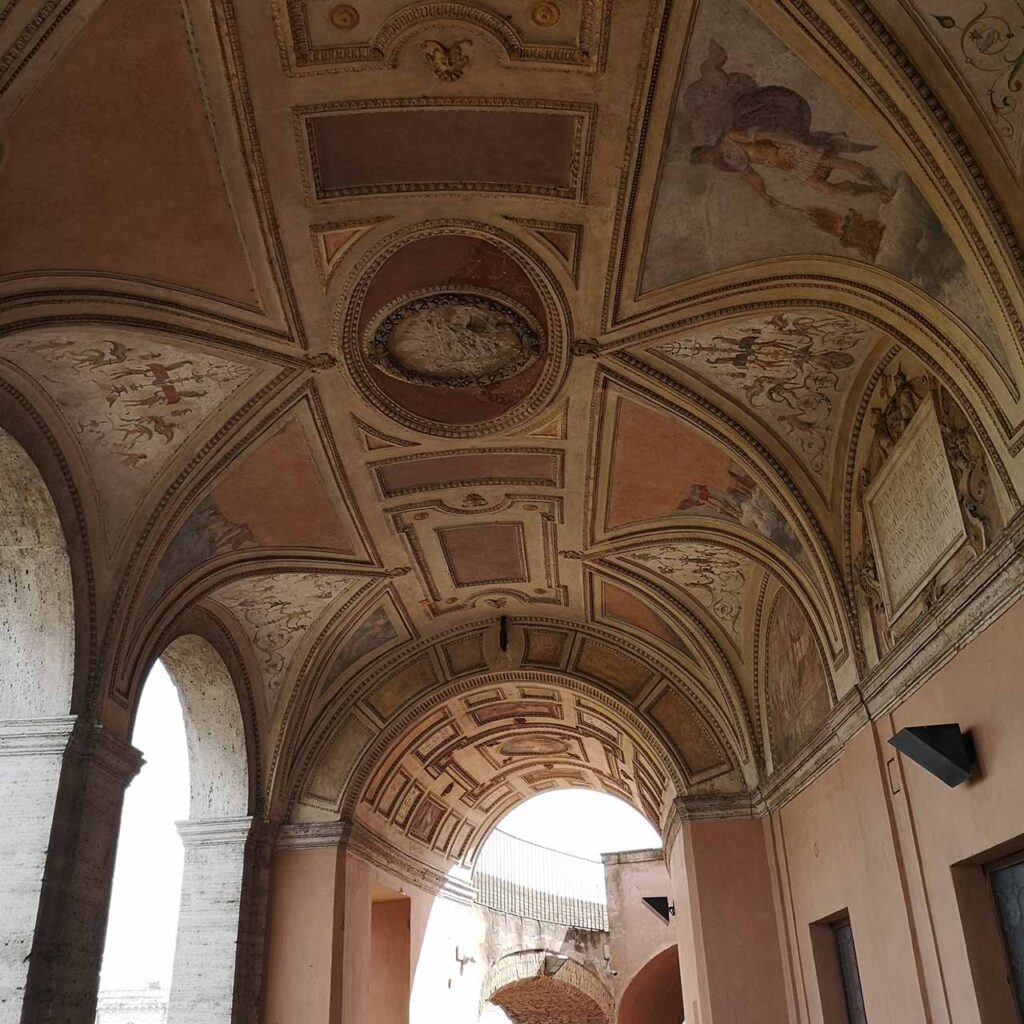
Next to that of Julius II is the more sumptuous Loggia of Paul III Farnese (1534-1549), built during one of the most important pontificates for the transformation of the castle into a papal residence. Paul III wanted to give the castle a face that was not only military, but above all renaissance and princely, worthy of a real palace.
The loggia is decorated with commemorative frescoes and stuccoes, in which Farnese heraldry dominates. Coats of arms, plant motifs and allegorical figures celebrate the power of the family and the centrality of the pope in the European politics of the time. The room, much larger and more solemn than Julius II's loggia, served as a ceremonial space in which to receive guests and ambassadors with the unique setting of Rome in the background.
Even today, looking out from the Loggia of Paul III, you have one of the most spectacular views of the city: on one side the Vatican, on the other hand the Tiber and the historic center. It is easy to imagine the effect this setting must have had on the pope's guests, combining artistic beauty and political power in a single glance.
Pauline Hall
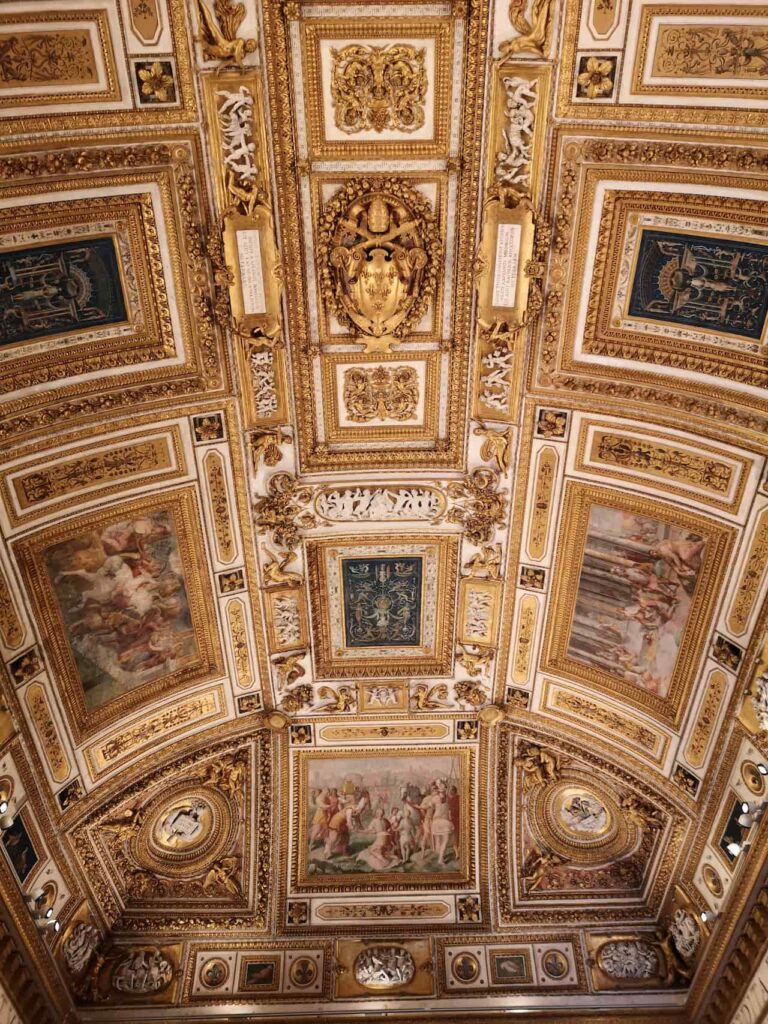
Among the wonders of the Museum of Castel Sant'Angelo, the Pauline Hall is undoubtedly one of the most spectacular and beloved stops for visitors. This large hall, which bears the name Paul III Farnese, was the heart of the papal apartments and served as a reception hall, where the pontiff received ambassadors, emperors and distinguished guests.
As soon as you cross the threshold, your gaze is caught by the rich pictorial decoration. Between 1545 and 1547 Pope Paul III commissioned the Perin del Vaga, a pupil of Raphael, and his workshop a grandiose cycle of frescoes. The iconographic program combines scenes from the life of Alexander the Great and of St. Paul's, figures chosen to recall the pope's name and celebrate his power and culture.
The barrel vault is a treasure chest of symbols: in the center stands the papal coat of arms of the Farnese family, surrounded by grotesques, stucco and cartouches with Greek and Latin inscriptions. All around, the walls depict episodes celebrating virtues such as the Strength, Justice, Temperance and Prudence. There is no shortage of allegories of the Liberal Arts, which reiterate the pontiff's love for Neoplatonic culture.
A curious detail? Under the large fresco of theArchangel Michael sheathing the sword (a symbol of the castle and its divine protection), two funny painted baboons: according to some they would be a playful allusion to author Giacomo Bertucci, according to others a reminder of an exotic gift received from the pope.
The floor you walk on is not the original one: the terracotta one was replaced in the eighteenth century with the current covering, decorated with the coat of arms of Innocent XIII. But the impact remains the same: to be in the Pauline Hall is to step back in time and relive the splendor of the Roman Renaissance.
Hall of Cupid and Psyche
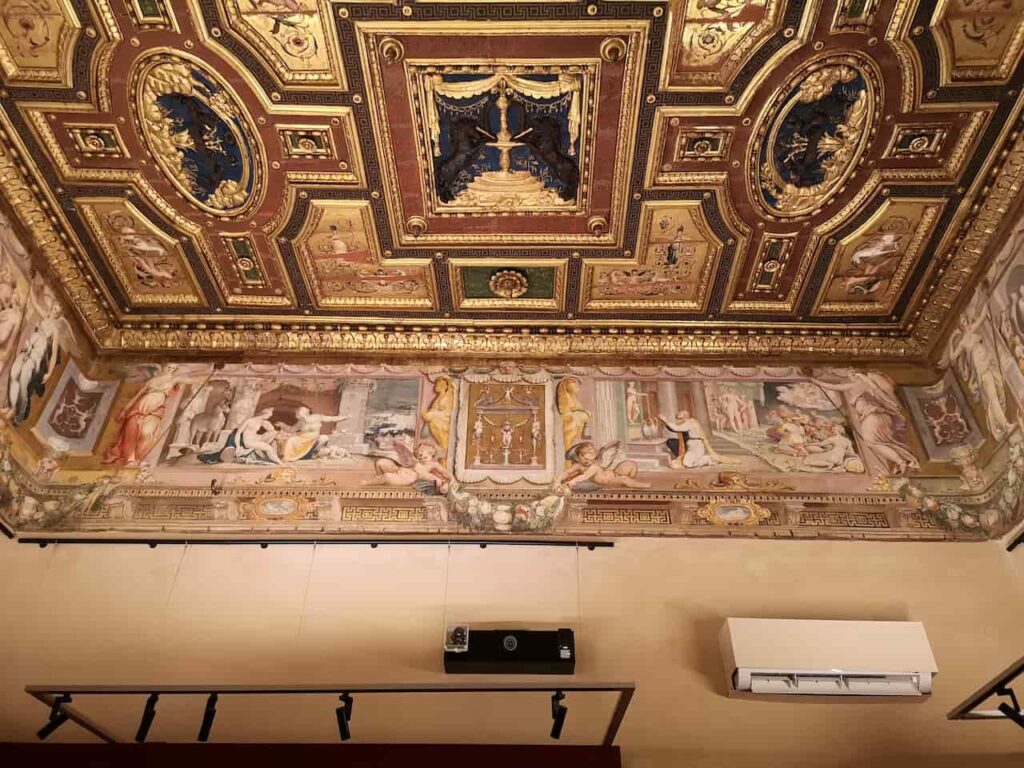
The Hall of Cupid and Psyche is one of the most surprising rooms in the Museum of Castel Sant'Angelo. Here you will find yourself immersed in an environment that combines the sophistication of Renaissance frescoes with the charm of an ancient and sensual history.
This room, which was originally the bedroom of Paolo III Farnese, was decorated by Perin del Vaga and his workshop. The pictorial cycle is inspired by the famous tale of Love and Psyche contained in Apuleius' "Golden Ass."
Look up and be captivated by the gilded coffered ceiling, full of grotesques, Farnese lilies and ornamental motifs. In the center stands a large papal coat of arms, symbol of the Farnese family. Along the walls, however, are ten panels illustrating episodes from the fable: from the first meeting between Cupid and Psyche to the famous scene in which Psyche discovers the face of her lover, until the happy epilogue of the divine wedding.
The frescoes alternate sensual scenes with allegorical figures and winged victories. Although the mythological theme was daring for a papal setting, Paul III's reading of it was neoplatonic: the story of Psyche, a soul in search of perfection, became an allegory of the spiritual path to truth.
In addition to the decoration, the hall now holds some valuable works: the Christ Carrier by Paris Bordon e The Bathroom by Dosso Dossi, which further enrich the visiting experience.
Walking in the Hall of Cupid and Psyche means experiencing firsthand the flavor of the Roman Renaissance, where myth and faith come together in a rich and fascinating artistic language.
Perseus Hall
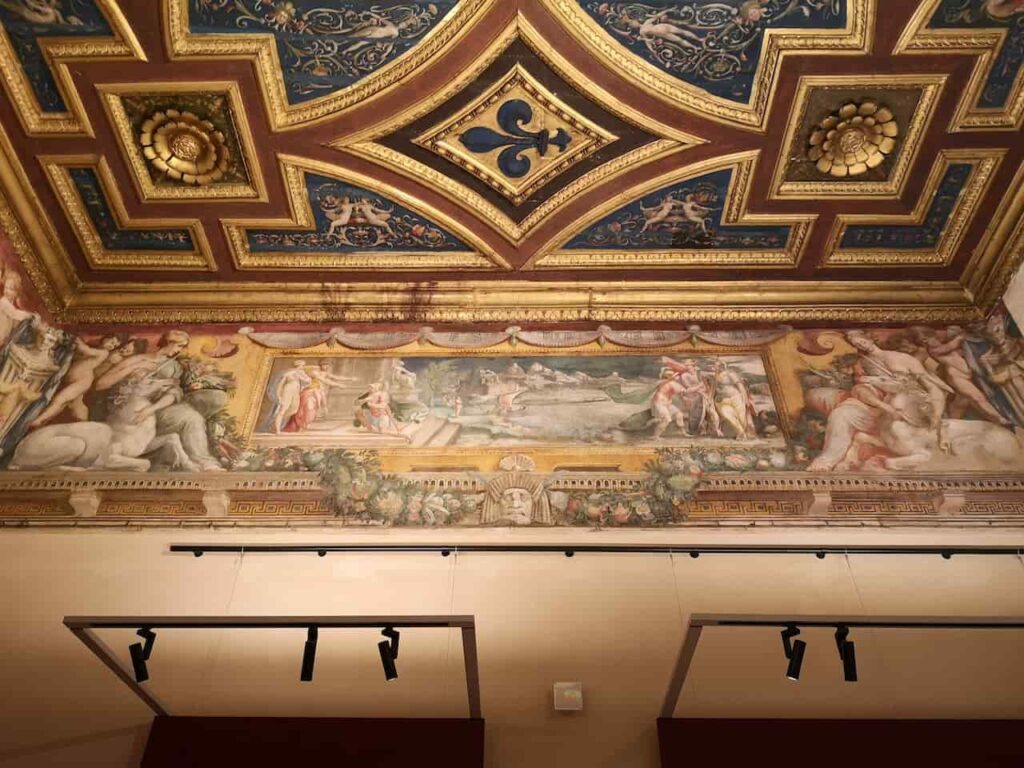
The Perseus Hall is one of the most refined and meaningful environments in the Museum of Castel Sant'Angelo. Originally it was the private study of Paul III Farnese, an intimate place designed for meditation and study, but at the same time charged with symbolic messages.
Here, too, the hand of Perin del Vaga and his team is evident: the walls and coffered ceiling are decorated with patterns of grotesque, coats of arms and symbols of the Farnese family. In the center of the vault stands out the relief with St. Michael the Archangel, protector of the castle.
The absolute protagonist, however, is Perseus, the hero of Greek mythology who defeated Medusa. His exploits are recounted in six large panels inspired by the Metamorphosis by Ovid. Following the pictorial cycle clockwise, you can recognize episodes such as:
- Perseus' parting from Danae, his mother.
- Mercury and Minerva's delivery of weapons..
- The decapitation of Medusa.
- The victorious return of the hero.
- The origin of coral, born from the blood of the monster.
- The wedding banquet with Andromeda.
Each scene is framed by mock Renaissance architecture with festoons of fruit, masks, and allegorical figures. There is no shortage of curious details, such as the female figures with unicorns, emblem of the Farnese family, recalling the purity and strength of the lineage.
Today the room also houses some works from the museum's collection, including the Christ blessing and the St. Onofrio by Carlo Crivelli, the St. Jerome by Lorenzo Lotto and a striking Lamentation over the Dead Christ Of unknown author.
The armory
The Armory of the Museum of Castel Sant'Angelo is one of the most fascinating sections for those who love military history. Here you can discover a unique heritage of weapons and armor that recount the castle's past as impregnable fortress and as a strategic center of papal defense.
The collection includes pieces ranging from antiquity to the modern period. You will find swords, helmets, armor, arquebuses and banners testifying to centuries of wars, sieges and defenses. Many artifacts come from excavations carried out in the basement and along the castle walls; others were recovered during restoration or donated by private individuals.
Among the most famous relics are theArchibugio Farnese, the lanzichen dagger scabbard, l'Elmo of Bolzano and even a garibaldian uniform dating back to the Risorgimento. These objects show how Castel Sant'Angelo has witnessed many different eras: from medieval battles to papal defense against the Lansquenets to its role as a prison and barracks in the 19th century.
A curious detail is that many of the weapons were found along the banks of the Tiber River during river rehabilitation works in the twentieth century. Among them were some medieval swords and spears that were probably used in the very defenses of the castle.

The best-selling ever
Castel Sant'Angelo: Entrance ticket + audio guide
Quick access and audioguide included: explore Castel Sant'Angelo and Roman Forum with one ticket.
Secure payment
Immediate confirmation
Cell phone ticket
Level 6 : Library and Treasury
The sixth level of Castel Sant'Angelo is one of the most fascinating spaces of the visit, because it takes you to environments related no longer to military defense or the daily life of the popes, but to the memory and wealth. Here, in fact, are the Library and the famous Treasure Hall, two places that embody the administrative and symbolic function of the fortress.
The route starts from the Pompeian Corridor, a passageway decorated with motifs inspired by Roman-era paintings. This corridor dramatically introduces an intimate and quiet room: the Library Room. Originally intended to store documents, records and precious texts, the library represented the intellectual heart of the papal residence. It was not only a repository of books, but also a space where the written memory of the papacy could be administered and the complex bureaucratic machine that ran from the castle managed.
But the most striking environment at this level is the Treasure Hall. As the name suggests, it was here that the papacy's most precious possessions were stored: gold, silver, secret documents and relics. The thick walls and guarded access made the room a true Renaissance vault, difficult to breach. Even today you can still feel the sensation of being in an armored place, designed to guarantee maximum security.
Symbolically, the sixth level brings together two basic elements of power: the wisdom and the wealth. On the one hand the books and archives, on the other the material treasury that secured the political and spiritual authority of the Church. Not surprisingly, these very rooms are among the most cared for and protected in the fortress.
The Level 6 closes the indoor route proper, before climbing outdoors onto the Angel Terrace.
Library Room
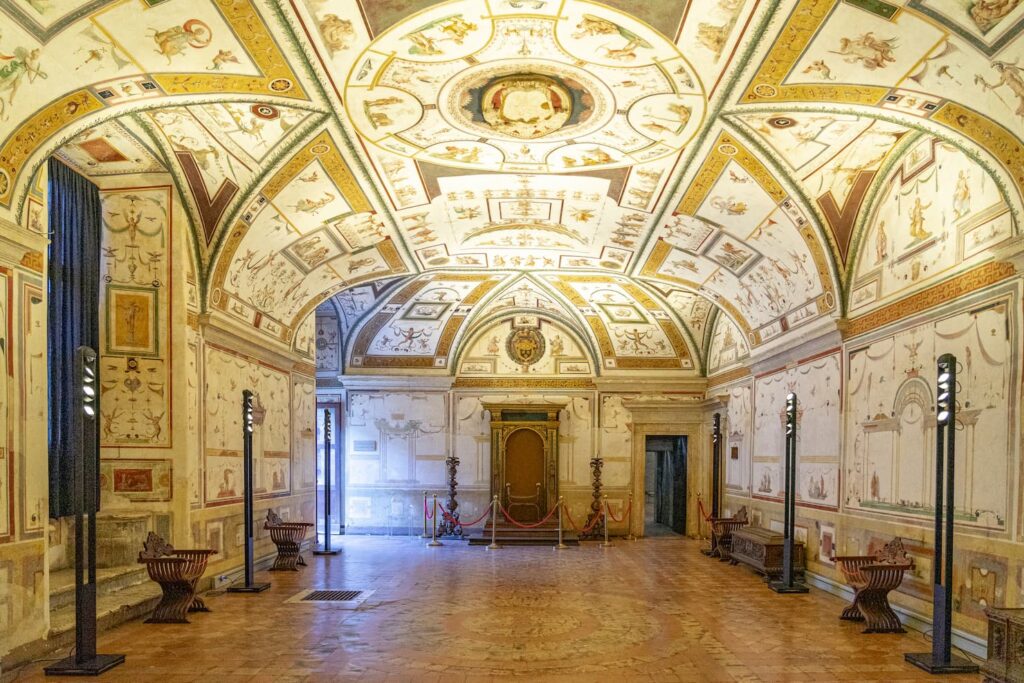
The Library Room is one of the most impressive and fascinating environments in the Museum of Castel Sant'Angelo. It is located in the north wing of the papal apartments and, despite its modern name, it had an even more prestigious function in the past: it housed part of theVatican Secret Archives, along with the nearby Treasury Hall.
The decoration was entrusted by Paul III Farnese a Luzio Luzi And to his workshop. Looking up, you will notice a monumental vault, decorated with grotesques, stucco and ten episodes from the Ancient Rome, testifying to the link between the papacy and the imperial legacy. Prominent among the depictions are allegories of the Church and of Rome, placed above the large fireplace, with the papal coat of arms of the Farnese family in the center.
On the sides of the vault run two continuous friezes: one with embossed bezels alternating pagan scenes with heraldic symbols, the other painted with sea creatures and medallions. The portraits of Adriano and of theArchangel Michael commemorate both the founder of the mausoleum and the Christian patron of the castle.
Treasure Hall
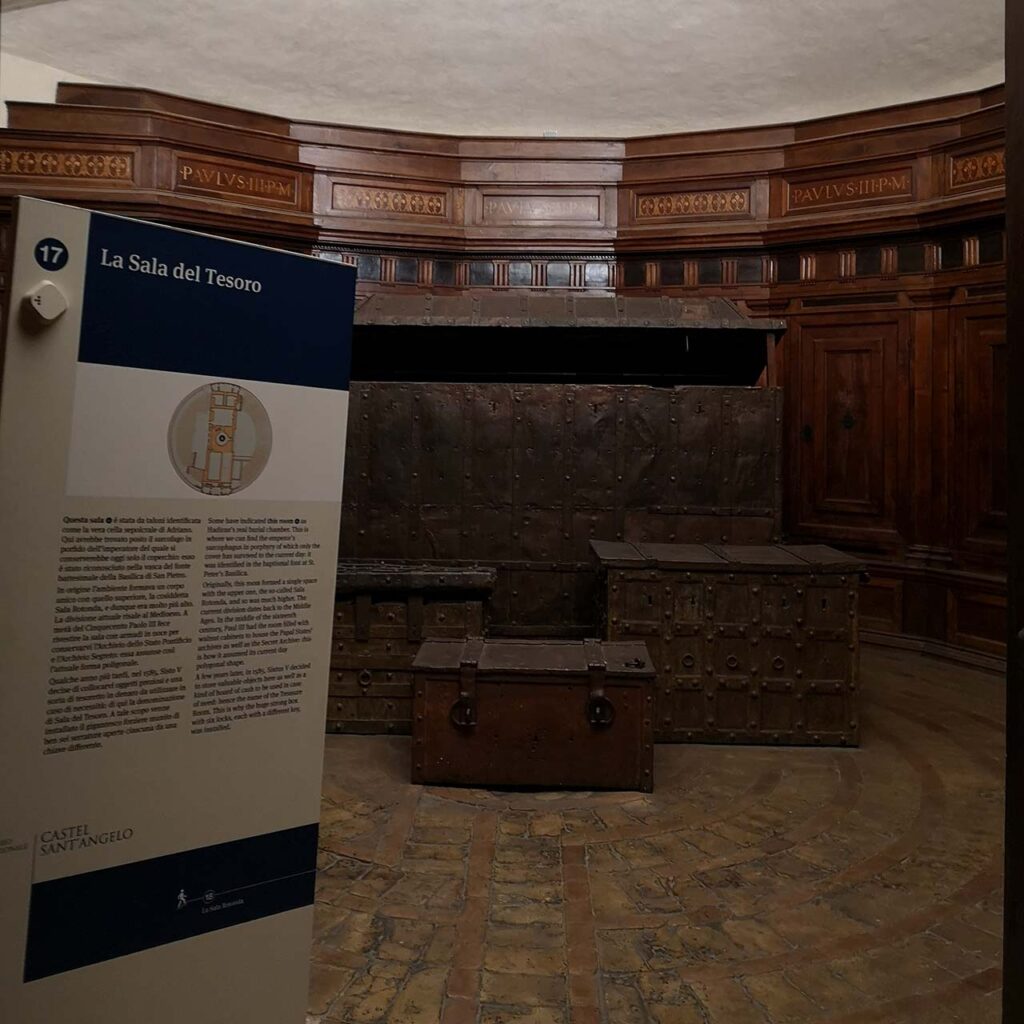
Next to the library is the Treasure Hall, one of the most historically charged rooms in Castel Sant'Angelo. It was originally intended to house thepapal state treasury And the most secret documents of the papacy.
The room is circular in shape and was equipped with walnut cabinets anchored to the walls, in which deeds, records and wealth were stored. Historical sources attest that here, as early as the end of the fifteenth century, a veritable golden reserve. In 1586, pope Sixtus V had the following placed inside the monumental hall iron caissons, which guarded the treasury intended for the defense of the state.
Access was tightly controlled: two doors locked by six locks, the keys to which were entrusted only to the Pope's Secret Treasurer and to the Cardinal Dean. A security system that makes us realize how crucial this place was for Vatican finances.
During the 19th century, the hall changed its function and was also used as a cell, but even today it retains the charm of a mysterious place, linked to the economic and political power of the papacy.
Visiting the Treasure Hall you will be able to imagine the immense riches it once held and understand why Castel Sant'Angelo was considered not only a fortress, but also a impregnable safe.
The Angel's Terrace

The visit to the interior of Castel Sant'Angelo culminates with the Angel Terrace, one of the most iconic and beloved spaces for visitors. After passing through corridors, courtyards and frescoed rooms, here we finally reach the open air, on the top of the fortress, where the famous statue of St. Michael the Archangel.
According to legend, it was on this very spot that, in 590, the archangel appeared to Pope Gregory the Great during a terrible plague, sheathing his sword as a sign of the end of the calamity. Since then Castel Sant'Angelo has borne the name of the warrior angel, a symbol of protection for Rome. The present bronze statue, the work of Peter Anton von Verschaffelt (1753), dominates the entire city with its solemn figure.
Also on the terrace is the Mercy Bell, which was played at solemn events or, more tragically, to accompany executions in the Shooting Courtyard. It is a reminder of how intertwined the castle's history is with moments of power and drama.
The real spectacle, however, is the panorama: From here you have one of the most extraordinary views of Rome. To the north stretches the Tiber with its bridges, to the south towers the dome of St. Peter's, while all around one can recognize the rooftops and monuments of the Eternal City. It is a unique perspective, which alone repays the climb through the castle levels.
Permanent collections in the interiors of Castel S.Angelo
In addition to the architectural and historical environments, the interiors of Castel Sant'Angelo guard a real diffuse museum, with permanent collections that enrich the tour route. These are not isolated rooms, but exhibition nuclei distributed along the various levels, allowing you to discover art masterpieces and historical evidence as you walk through the castle.
The richest part is the Picture gallery, set up between the fourth and fifth levels, collecting paintings from the Renaissance to Baroque. Here you can admire works by artists such as Luca Signorelli, Charles Crivelli e Guercino, which testify to the prestige of the papal collections and the desire to transform Castel Sant'Angelo into an artistic as well as military palace.
Another important section is that devoted to the renaissance pottery, displayed in special rooms and mostly from Italian manufactures between the 15th and 16th centuries. They are fine objects, often decorated with coats of arms and mythological motifs, that tell of the daily life and aesthetic taste of the courts of the time.
There is no shortage of sculptures, many of them from excavations and papal collections. Ancient statues, busts and architectural fragments dialogue with the spaces of the castle, creating an itinerary that interweaves archaeology and Renaissance art.
Renaissance ceramics
Among the most fascinating treasures held by the Museum of Castel Sant'Angelo there are the renaissance pottery, a collection of objects that tell the story of everyday life and artistic taste in the 16th century. These are not just simple utensils, but true works of art in miniature, combining functionality and aesthetic refinement.
Many pieces come directly from the castle, found during excavations and restoration in the underground rooms and papal kitchens. These are plates, pitchers, bowls and containers used as much in the solemn banquets of pontiffs as in court life. The surfaces are decorated with Colorful glazes and geometric or floral patterns, often embellished with heraldic symbols and mythological figures.
Renaissance pottery also had a strong symbolic value: it was not only an object of common use, but represented the prestige and wealth Of those who owned it. This is why many of the ceramics in Castel Sant'Angelo are decorated with coats of arms of noble families or with sacred images that refer to Christian spirituality.
As you walk through the display cases that house these artifacts, you will have the opportunity to take a close look at the details of the workmanship, the colors that still retain an amazing brilliance, and the elegance of the forms. It is a way to discover not only the history of the castle, but also an important piece of the material culture of the Italian Renaissance.
The picture gallery
The picture gallery of the Museum of Castel Sant'Angelo is one of the most valuable and fascinating collections in the museum itinerary. It holds Paintings ranging from the Renaissance to the Baroque, with works that testify to the artistic wealth of papal Rome and the refined taste of the noble families who contributed to enriching the castle over the centuries.
Many of the paintings come from private donations, such as those of the Contini Bonaccorsi and of the Menotti, who offered the museum entire rooms furnished with furniture and works of art. Thanks to these legacies, today you can admire canvases of extraordinary quality ranging from religious subjects to allegorical scenes, from portraits of famous people to landscapes.
Among the most interesting paintings are works by great Italian masters, such as the Christ blessing by Carlo Crivelli, the St. Jerome by Lorenzo Lotto and other canvases that testify to the variety of painting styles and schools that flourished in Rome and Italy between the 15th and 17th centuries.
The picture gallery is not just a collection of pictorial works: it is a true account of the papal and noble patronage, capable of reflecting the values, spirituality and political ambitions of the time. As you enter these rooms, you will quickly realize how art was an instrument of power and representation.
Unlike large Roman galleries such as the Borghese Gallery o Barberini Palace, the Castel Sant'Angelo picture gallery has a more intimate character: it did not begin as the official collection of a family, but as a collection of works that over time found a new home within the castle walls.
The sculptures
The section of the sculptures from the Museum of Castel Sant'Angelo allows us to rediscover the oldest soul of the monument, linked to its original role as a mausoleum of the emperor Hadrian. In fact, during the excavation and restoration of the castle, numerous fragments of the Roman sculptural decoration, which we can admire today within the museum itinerary.
These artifacts tell the story of the grandeur of the imperial tomb. Among the most important pieces are. capitals, friezes, reliefs and statues that once adorned the mausoleum, along with fragments of the marble decorations that lined the entire building. The Romans loved to embellish their funerary monuments with symbolic images and allegorical figures, and Castel Sant'Angelo was no exception.
Some fragments depict plant and animal motifs, others recall the mythological world. There is no shortage of elements related to imperial worship, such as busts and inscriptions that celebrated the memory of the Antonines buried in the mausoleum.
The sculpture section is not limited to the Roman period: the museum also holds later works, including renaissance sculptures and decorations that were part of the papal apartments. In this way the sculptures recount all the transformations of the castle, from mausoleum to fortress, from papal residence to national museum.
To walk among these works is to reconstruct, piece by piece, the original face of the Mole Adriana and realize the artistic richness that characterized the monument even in the first centuries of its history.
Symbols and details not to be missed
Visiting the interiors of Castel Sant'Angelo it is not only the great halls or monumental courtyards that impress you. In every corner of the castle are hidden symbols, inscriptions and decorative details that tell stories of popes, powerful families and ancient traditions. These are small clues that enrich the visit and are worth watching carefully.
One of the most famous is the motto "Festina lente" ("hasten slowly"), which camps in family-related circles Farnese. This oxymoron, dear to Paul III, encapsulates the idea of a prudent but decisive power, ready to act with wisdom and determination.
Also appearing in several environments are unicorns, mythological animals adopted as a heraldic symbol by the Farnese family itself. They represent purity and strength tamed by faith, a political and spiritual message that the popes wanted to communicate to visitors to the castle.
In the frescoed rooms you will also find a rich array of grotesques and cameos, ornamental motifs typical of the Renaissance inspired by antiquity, transforming the walls into veritable webs of fantastic figures, gods and allegories. These are details that link the castle to the decorative tradition of the Roman Domus, which were rediscovered at that time.
One fascinating detail is found engraved on a tombstone: the Latin verses "Animula vagula blandula", taken from a poem by Emperor Hadrian, evoking the theme of the fragility of the soul in the face of death. It is a detail that brings the memory back to the first meaning of the monument: the burial mausoleum Of the emperor and his dynasty.
Finally, prominent in many papal circles are the heraldic coats of arms of the pontiffs' families (Medici, Farnese, Borgia, Della Rovere) who left nothing to chance: every symbol was a political manifesto, a way to stamp their power on the walls of the fortress.
Looking beyond the monumental spaces, it is precisely these small details to tell you the castle's most intimate and authentic story: that of its protagonists and their messages hidden in the stone and frescoes.
FAQ on the interior of Castel Sant'Angelo
A complete tour of the interior of Castel Sant'Angelo takes on average. 1 1/2 to 2 hours, but it can be prolonged if you linger in the museum's frescoed rooms or collections.
Inside the castle you can visit the helical ramp, the Urn Hall, the prisons, i papal courtyards, the renaissance lodges, the spectacular Pauline Hall, the Library, the Treasure Hall and the Angel Terrace With the statue of St. Michael.
Yes, part of the historical prisons Is part of the visitation path. You can see the cells and the Talking bowl, where interrogations were conducted.
The permanent collections are distributed along the route: the Picture gallery Between the fourth and fifth levels, the renaissance pottery in the dedicated rooms, the ancient sculpture in various environments and theArmory at the fifth level.
Of all the environments, the Pauline Hall is considered the absolute masterpiece, thanks to the celebratory frescoes painted by Perin del Vaga and his school.
The Passetto di Borgo, the famous elevated corridor that connects Castel Sant'Angelo to the Vatican, cannot be visited every day. It is opened only on special occasions or for dedicated guided tours. To walk through it is to relive the escapes of popes, such as that of Clement VII during the Sack of Rome in 1527.
After admiring the papal halls and secret passages of the castle, you can continue your itinerary to discover another hidden Rome: the catacombs of Rome, an intricate labyrinth of underground tunnels rich in history and spirituality.